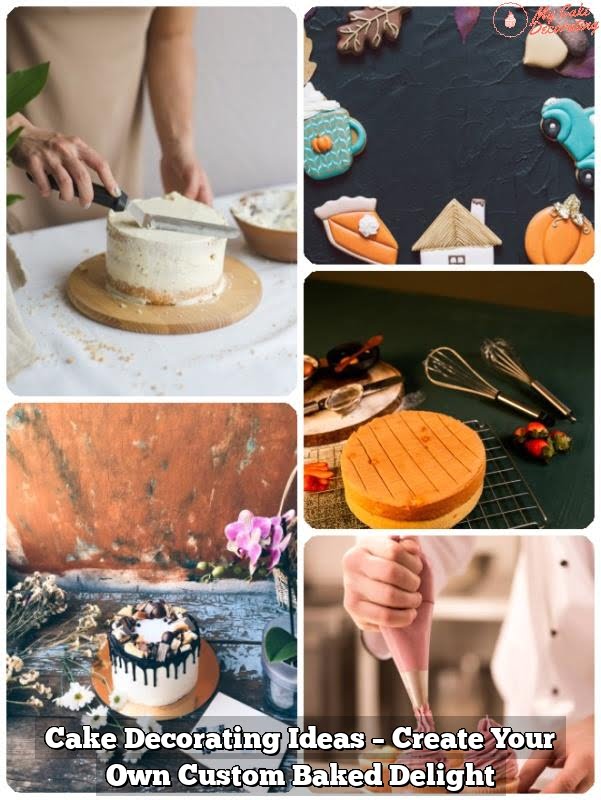Decorating a home baked cake is not just about making it look visually appealing; it’s also about adding a personal touch and showcasing your creativity. Whether you’re baking a cake for a special occasion or simply want to elevate your everyday dessert, knowing how to decorate a cake can make all the difference.
From choosing the right frosting to mastering various decorating techniques, there are plenty of ways to turn a simple homemade cake into a work of art.
The key to decorating a home baked cake lies in having the essential tools and supplies on hand. It’s important to have the right equipment, such as spatulas, piping bags, and offset spatulas, to achieve professional-looking results.
Additionally, selecting the appropriate frosting and icing can significantly impact the overall look and taste of your cake. By understanding the basics of cake decoration, you can transform even the most basic baked goods into showstopping desserts that will impress your guests.
In this article, we will explore everything you need to know about decorating a home baked cake. From learning how to crumb coat and layer your cake for seamless decorations to experimenting with creative techniques like piping, fondant, and sprinkles, we’ve got you covered.
By following our step-by-step guide and incorporating our tips for achieving smooth frosting finishes, you’ll be able to create beautifully decorated cakes that rival those from professional bakeries. So let’s delve into the world of cake decoration and unleash your inner pastry chef.
Essential Tools and Supplies Needed for Cake Decoration
When it comes to decorating a home baked cake, having the right tools and supplies is essential to achieving a professional-looking result. Here are some must-have items you’ll need in your cake decorating toolkit:
- Piping bags and tips: These are essential for creating designs and writing on your cake with frosting or icing.
- Offset spatula: This tool will help you spread frosting evenly on your cake layers and create smooth finishes.
- Bench scraper: Use this tool to create sharp edges on your frosted cake and smooth out any imperfections.
- Fondant smoother: If you plan on working with fondant for your cake decorations, a fondant smoother will help you achieve a polished look.
- Decorating comb: For textured designs on the sides of your cake, a decorating comb can create beautiful patterns.
In addition to these basic tools, having a variety of edible supplies is important for adding flair to your decorated cake. Consider stocking up on items such as:
- Edible glitter or luster dust
- Sprinkles in various shapes, sizes, and colors
- Edible flowers or petals for an elegant touch
- Chocolate shavings or curls for added texture
- Fresh fruits or berries for a pop of color and flavor
With the right tools and supplies at your disposal, you’ll be well-equipped to bring your creative vision to life when decorating your home baked cake. Whether you prefer classic designs or more whimsical creations, having a variety of options at hand will allow you to experiment and showcase your unique style.
Choosing the Right Frosting and Icing for Your Cake
When it comes to decorating a home-baked cake, choosing the right frosting and icing is crucial to achieving the desired look and taste. There are various options available, each with its own unique properties and flavor profiles. Understanding the differences between frosting and icing can help you make the best choice for your cake.
Types of Frosting
One popular type of frosting is buttercream, which is made from butter, powdered sugar, and flavorings. Buttercream is versatile and can be easily colored and flavored to suit your preferences. Another common option is cream cheese frosting, which has a tangy flavor that pairs well with rich cakes like red velvet. Ganache, made from chocolate and cream, provides a glossy finish perfect for decadent chocolate cakes.
Types of Icing
Royal icing is often used for intricate designs like piping flowers or writing messages on cakes. While royal icing dries hard and smooth, it may not be as flavorful as other options. Fondant icing offers a smooth finish that can be molded into various shapes and designs. However, some find fondant too sweet or lacking in flavor compared to other types of icing.
Considering the flavor profile you want to achieve and the design you have in mind will help you determine whether frosting or icing is the best choice for your home-baked cake decoration project. Experimenting with different options will allow you to discover what works best for your tastes and decorating style when creating a beautifully adorned cake at home.
Step-by-Step Guide to Crumb Coating and Layering Your Cake for Decorating
When it comes to decorating a home-baked cake, mastering the art of crumb coating and layering is essential for achieving a professional-looking finish. Crumb coating involves applying a thin layer of frosting to seal in any loose crumbs before adding the final layer of frosting. This technique not only helps to create a smooth surface for decorating but also ensures that your cake layers stay moist and delicious.
To start, make sure you have all the necessary tools and supplies on hand, including an offset spatula, cake turntable, and bench scraper. Once your cakes are baked and cooled, level off the tops if needed to ensure even layers. Place a dollop of frosting on your cake board or serving platter to secure the first layer of cake in place.
Next, apply a thin layer of frosting on top of the first layer using an offset spatula, making sure to fill in any gaps between the layers. Repeat this process with the remaining layers, ensuring each one is level before moving on. Once all layers are stacked, use a bench scraper to smooth out the sides and top of the cake for a clean finish.
Remember that practice makes perfect when it comes to crumb coating and layering your cake for decorating. Don’t be afraid to experiment with different techniques and find what works best for you. By mastering this step-by-step guide, you’ll be well on your way to creating stunning cakes that not only taste amazing but look professionally decorated as well.
| Key Points | Details |
|---|---|
| Importance of Crumb Coating | Creates a smooth surface for decorating and keeps cake moist |
| Tools Needed | Offset spatula, cake turntable, bench scraper |
| Tips for Success | Level cakes, secure layers with frosting, use bench scraper for smooth finish |
Creative Cake Decorating Techniques
Decorating a home-baked cake can truly elevate its appearance and make it a show-stopping centerpiece for any occasion. Creative cake decorating techniques such as piping, fondant work, and sprinkles can add texture, color, and personality to your dessert creation. Whether you are a beginner or an experienced baker, exploring these techniques can take your cake decorating skills to the next level.
When it comes to piping, having the right tools is essential. Invest in a good quality piping bag and various tips to create different shapes and designs on your cake. From simple lines and dots to intricate flowers and borders, piping allows you to express your creativity in a fun and artistic way. Practice with different tip sizes and techniques to master the art of piping on your cakes.
If you want to add a smooth and professional look to your cake, consider working with fondant. Fondant is a versatile sugar paste that can be rolled out like dough and draped over cakes for a clean finish. It also serves as a blank canvas for sculpting intricate designs or creating 3D decorations. Experiment with different colors, textures, and molds to create stunning fondant decorations that will impress your guests.
For those looking to add some sparkle and fun to their cakes, sprinkles are the way to go. Whether you prefer classic rainbow sprinkles or shimmering gold dust, sprinkles can instantly bring life and excitement to your dessert. You can sprinkle them on top of frosted cakes or use them in between layers for added crunchiness. Get creative with different types of sprinkles such as nonpareils, jimmies, or sanding sugar to give your cake that extra special touch.
Tips for Achieving Smooth and Even Cake Frosting
Decorating a home-baked cake is not only about making it look visually appealing but also about ensuring that the frosting is smooth and even. Achieving a flawless finish on your cake can elevate its presentation and overall appeal. There are several tips and techniques you can follow to master the art of smooth and even cake frosting.
One essential tip for achieving smooth and even cake frosting is to start with a properly crumb-coated cake. This means applying a thin layer of frosting initially to seal in any crumbs on the surface of the cake. Once the crumb coat sets, you can then apply a final layer of frosting for a clean and polished look. This step helps to prevent any loose crumbs from ruining the overall appearance of your decorated cake.
Another key tip is to use an offset spatula for applying and spreading the frosting onto the cake. The angled design of an offset spatula allows for better control and precision when smoothing out the frosting. By using long, sweeping motions with the spatula, you can achieve an even layer of frosting on the top and sides of the cake. Additionally, rotating the cake as you frost it will help ensure that all areas are covered evenly.
To add extra finesse to your cake frosting, consider investing in a bench scraper or icing smoother. These tools are perfect for achieving straight edges and smooth finishes on your cakes. By holding the bench scraper or icing smoother against the sides of the cake while turning it on a rotating stand, you can create professional-looking results. Practice and patience are key when it comes to mastering the technique of achieving smooth and even cake frosting.
| Tip | Description |
|---|---|
| Start with a crumb coat | Applying a thin initial layer of frosting to seal in crumbs |
| Use an offset spatula | For precise application and spreading of frosting |
| Invest in bench scraper or icing smoother | To achieve straight edges and smooth finishes on cakes |
Decorating With Edible Flowers, Fruits, and Other Garnishes
Decorating a home-baked cake with edible flowers, fruits, and other garnishes is a wonderful way to elevate the look and taste of your creation. Not only does it add a burst of color and freshness to the cake, but it also provides additional textures and flavors that can take your dessert to the next level. Edible flowers such as roses, pansies, violets, lavender, and chamomile are not only beautiful but add a delicate floral essence to your cake.
Choosing the Right Edible Garnishes
When selecting edible flowers and fruits for decorating your cake, it is important to ensure that they are safe for consumption. Avoid using flowers or plants that have been treated with pesticides or chemicals. Instead, opt for organic options that are specifically labeled as edible. Fruits like berries, citrus slices, kiwi slices, and mango chunks make great additions to your cake both in terms of aesthetics and taste.
Arranging Edible Garnishes
Once you have chosen the edible flowers and fruits you want to use for decorating your home-baked cake, it’s time to arrange them on top. You can simply scatter them around the edges or create a beautiful pattern by placing them strategically on the surface of the cake. Be creative with how you arrange the garnishes to create an eye-catching design that complements the overall look of your cake.
Including edible garnishes in your cake decoration not only adds a touch of elegance but also allows you to incorporate natural elements into your dessert presentation. Experiment with different combinations of colors and textures to create visually stunning cakes that will impress your guests. With some creativity and attention to detail, you can easily transform a simple homemade cake into a work of art that looks as good as it tastes.
Troubleshooting Common Cake Decorating Mistakes and How to Fix Them
As much as we strive for perfection when decorating a home baked cake, sometimes mistakes can happen along the way. But fear not, as there are solutions to common cake decorating mishaps that can help salvage your masterpiece. One common issue that many encounter is air bubbles in the frosting or icing, leaving an unsightly finish on the cake. To fix this, simply use a toothpick or small spatula to gently poke the bubbles and smooth out the surface.
Another common mistake when decorating a cake is uneven frosting or icing application, resulting in an inconsistent look overall. To remedy this, use a bench scraper or offset spatula to apply a thin layer of frosting over the entire cake before adding more layers for a smoother finish. This technique, known as crumb coating, helps create a clean base for decorating and ensures a professional-looking result.
Additionally, if you find that your cake decorations are not sticking properly to the surface of the cake, consider using a dab of extra frosting or edible glue to secure them in place. This will prevent any decorations from sliding off or losing their shape. By addressing these common cake decorating mistakes with simple solutions, you can elevate your home baked cakes to a whole new level and impress your friends and family with your skills.
Conclusion
In conclusion, decorating a home-baked cake is not just about making it visually appealing; it is also a way to showcase your creativity and personality. By following the essential tools, choosing the right frosting, mastering layering techniques, and exploring creative decorating methods like piping and fondant, you can elevate your cake decorating skills to pro levels. Remember, practice makes perfect, so don’t be afraid to experiment with different techniques and designs.
One of the key aspects of showcasing your decorated home-baked cake like a pro is paying attention to details. Whether it’s using edible flowers, fresh fruits, or other garnishes, these little touches can make a big difference in the overall presentation of your cake. Additionally, making sure your frosting is smooth and even will give your cake a polished finish.
If you encounter any common cake decorating mistakes along the way, don’t fret. From fixing cracks in fondant to smoothing out air bubbles in buttercream, there are solutions to every problem. With patience and persistence, you can master the art of decorating a home-baked cake beautifully. So go ahead, unleash your creativity and enjoy the process of turning a simple homemade treat into a stunning masterpiece that will impress family and friends alike.
Frequently Asked Questions
How Can I Decorate My Homemade Cake?
Decorating a homemade cake can be a fun and creative process. One way to decorate your cake is by using fresh fruits like berries, kiwi, or citrus slices.
Another option is to adorn the top with edible flowers or herbs for a beautiful touch. You can also consider using chocolates, candies, or sprinkles to add color and texture to your creation.
How Do You Make a Cake Look Amazing?
Making a cake look amazing involves paying attention to details and presentation. One way to elevate the appearance of your cake is by using different piping techniques with icing to create intricate designs or patterns.
Adding layers of frosting between each cake layer can also give it a professional look. Additionally, you can use edible decorations like fondant shapes, edible glitter, or even personalized messages on the cake.
How to Decorate a Cake at Home Easy Without Icing?
If you want to decorate a cake at home without using traditional icing, there are still plenty of creative options available. One simple yet effective way is to dust powdered sugar or cocoa powder over the top of the cake using stencils to create decorative patterns.
Fresh whipped cream can also be used as an alternative to icing, adding a light and airy touch to the dessert. Another idea is to drizzle chocolate ganache or caramel sauce over the cake for an elegant finish without needing traditional icing techniques.

Welcome to my blog about home and family. This blog is a place where I will share my thoughts, ideas, and experiences related to these important topics. I am a stay-at-home mom with two young children. I hope you enjoy reading it! and may find some helpful tips and ideas that will make your home and family life even better!





